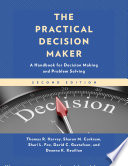

The book emphasizes the importance of structured decision-making frameworks. It delves into various models that aid in systematically approaching decisions, such as the Rational Decision-Making Model, which involves identifying the problem, gathering information, evaluating alternatives, and making a choice. The author argues that using frameworks helps to minimize biases and emotional influences, leading to more objective and effective outcomes. By applying these frameworks, decision-makers can enhance their analytical skills and improve the quality of their decisions, ultimately leading to better organizational performance.
Continue readingIn today's data-driven world, the book highlights the critical role of data in the decision-making process. It discusses how to collect, analyze, and interpret data to inform decisions effectively. The author stresses the importance of distinguishing between qualitative and quantitative data and using both to gain a comprehensive understanding of the situation at hand. The text provides practical examples of how data can be leveraged to predict outcomes, assess risks, and evaluate the potential impact of different choices. The emphasis is on using data not just as a tool but as a foundational element of strategic decisions.
Continue readingThe book explores the intersection of emotional intelligence (EI) and decision-making. It posits that understanding one's emotions and those of others can significantly influence the decision-making process. The author explains how high EI can lead to better interpersonal relationships, improved communication, and enhanced collaboration, all of which are crucial in making informed decisions. The text provides strategies for developing EI, such as self-awareness, empathy, and active listening, and illustrates how these skills can help mitigate conflicts and foster a more conducive environment for decision-making.
Continue readingRisk is an inherent part of decision-making, and the book emphasizes the importance of assessing and managing risks effectively. It introduces various risk assessment tools and techniques, such as SWOT analysis and scenario planning, to help decision-makers identify potential risks and their implications. The author also discusses the concept of risk tolerance and how understanding one’s own risk appetite can guide decisions. By incorporating risk management strategies into the decision-making process, leaders can make more informed choices that balance potential rewards with associated risks.
Continue readingThe book highlights how group dynamics can significantly influence decision-making processes. It discusses the effects of groupthink, conformity, and polarization on the quality of decisions made in teams. The author provides insights into fostering a culture of open dialogue and constructive dissent, which can lead to more robust decision-making. Techniques for facilitating effective group discussions and ensuring diverse perspectives are included, emphasizing the need for leaders to create an environment where all voices are heard and valued.
Continue readingEthics play a crucial role in decision-making, and the book addresses the importance of integrating ethical considerations into the decision-making process. The author discusses various ethical frameworks, such as utilitarianism and deontological ethics, and how they can guide leaders in making morally sound decisions. The text provides case studies that illustrate the consequences of ethical and unethical decisions, underscoring the need for transparency and integrity in leadership. By prioritizing ethics, decision-makers can build trust and credibility within their organizations.
Continue readingThe final key idea presented in the book is the necessity of continuous learning and adaptation in decision-making. The author argues that the business landscape is constantly evolving, and decision-makers must be willing to learn from past experiences and adapt their strategies accordingly. This includes embracing feedback, analyzing outcomes, and being open to change. The text encourages a mindset of lifelong learning, where leaders seek new knowledge and insights to enhance their decision-making capabilities, ultimately leading to sustained organizational success.
Continue reading